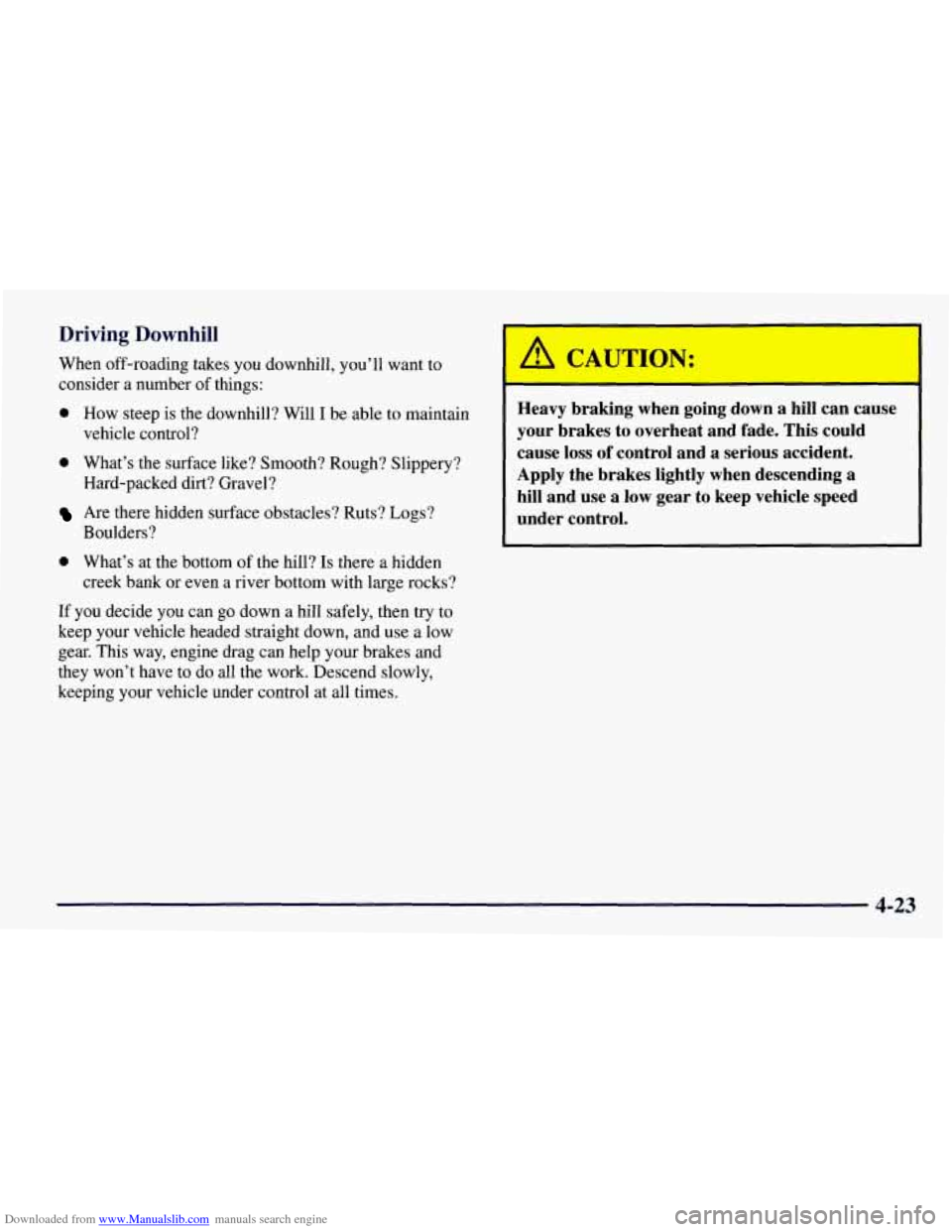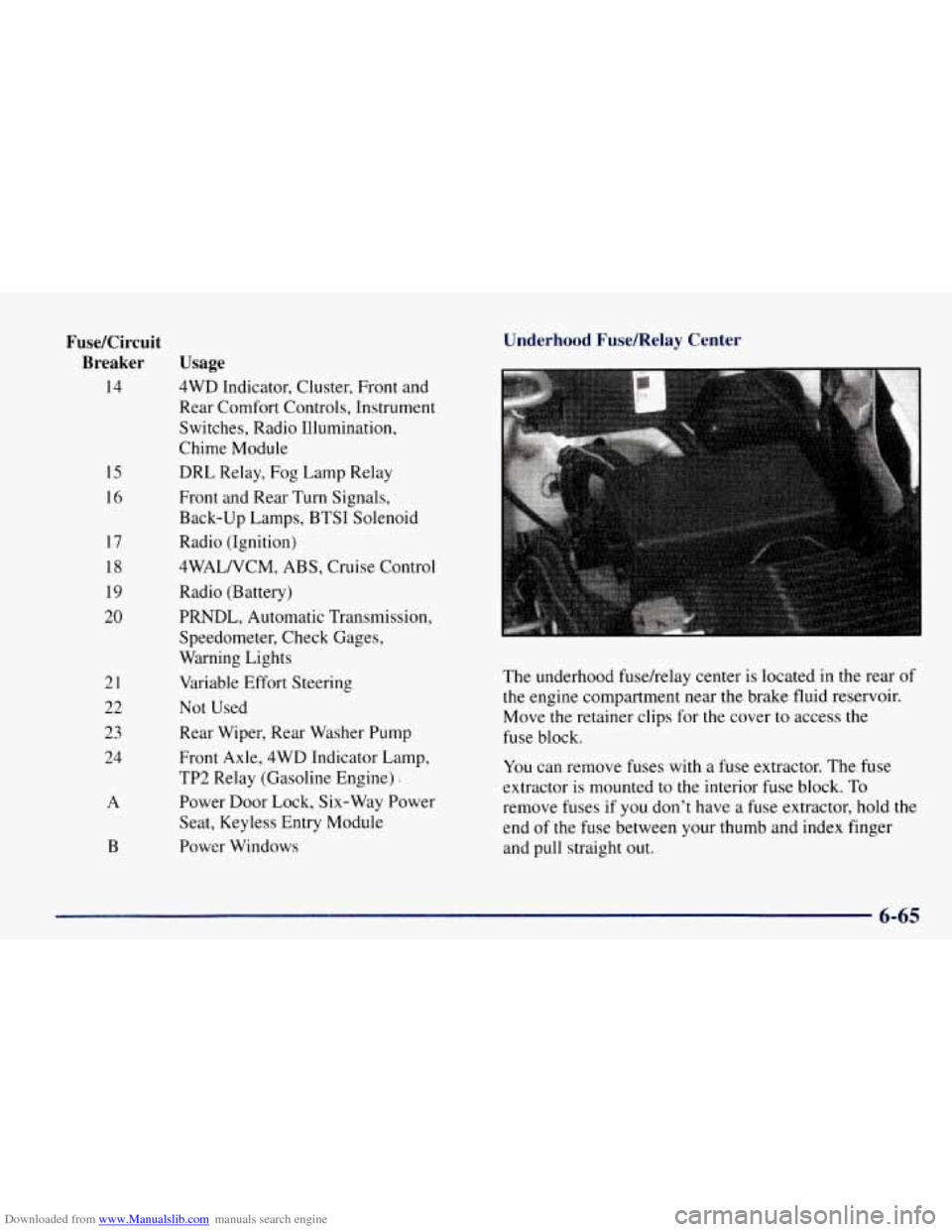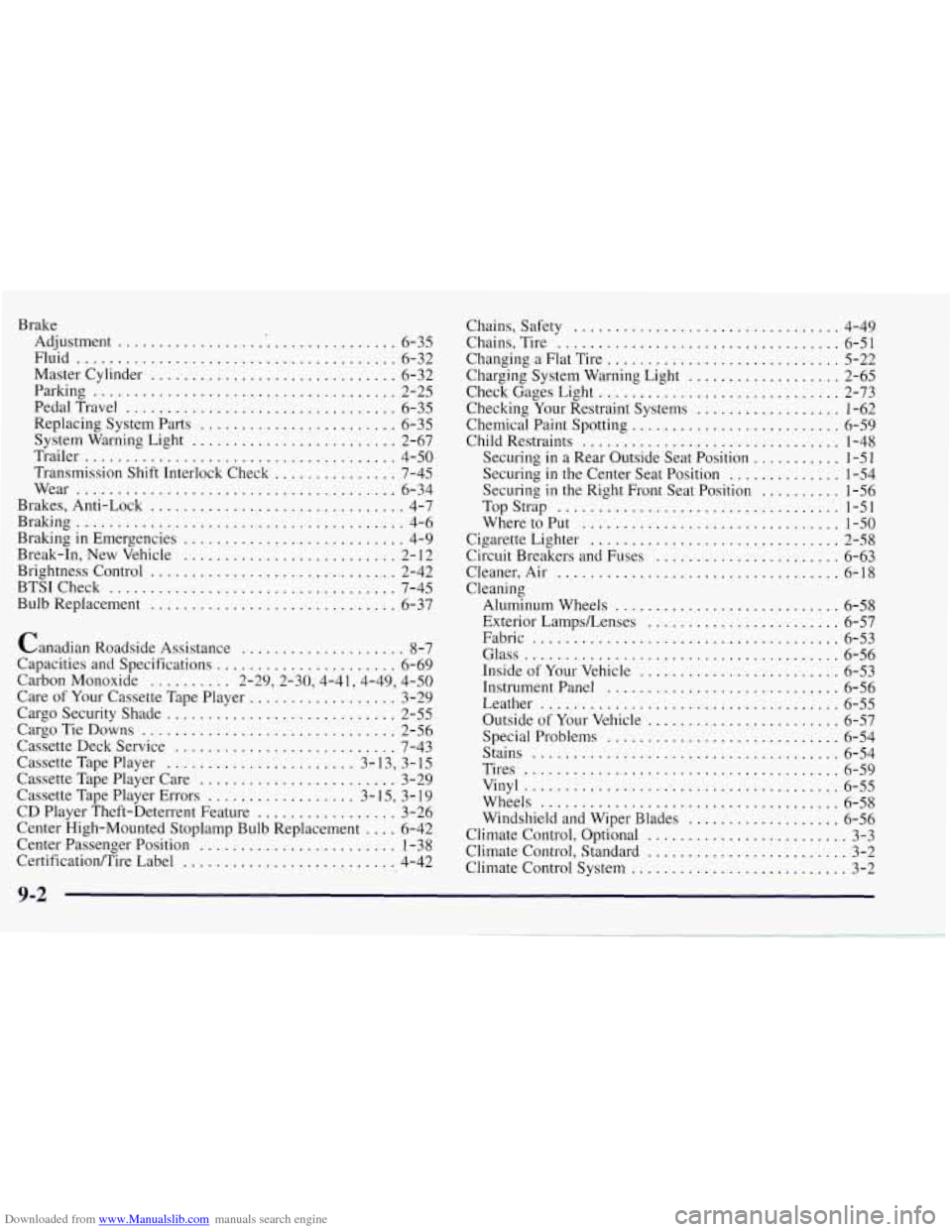1997 CHEVROLET TAHOE brake light
[x] Cancel search: brake lightPage 202 of 433

Downloaded from www.Manualslib.com manuals search engine Driving Downhill
When off-roading takes you downhill, you’ll want to
consider
a number of things:
0 How steep is the downhill? Will I be able to maintain
vehicle control?
0 What’s the surface like? Smooth? Rough? Slippery?
Hard-packed dirt? Gravel?
Are there hidden surface obstacles? Ruts? Logs?
Boulders?
0 What’s at the bottom of the hill? Is there a hidden
creek bank or even a river bottom with large rocks?
If you decide you can go down a
hill safely, then try to
keep your vehicle headed straight down, and use a low
gear. This way, engine drag can help your brakes and
they won’t have to do all the work. Descend slowly,
keeping your vehicle under control at all times.
I
A C UTT3N:
I
Heavy braking when going down a hill can cause
your brakes to overheat and fade. This could cause loss
of control and a serious accident.
Apply the brakes lightly when descending a
hill and use a low gear to keep vehicle speed
under control.
4-23
Page 206 of 433

Downloaded from www.Manualslib.com manuals search engine Hard packed snow and ice offer the worst tire traction.
On these surfaces, it’s very easy to lose control. On wet
ice, for example, the traction is
so poor that you will
have difficulty accelerating. And if
you do get moving,
poor steering and difficult braking can cause you to slide
out of control. through.
Also, water that deep can damage your axle
and other vehicle parts.
If the water isn’t too deep, then drive through it slowly. At
fast speeds, water splashes on your ignition system and
your vehicle can stall. Stalling can
also occur if you get
your tailpipe under water. And, as long as your tailpipe
is
under water, you’ll never be able to start your engine.
When you
go through water, remember that when your
brakes get wet, it may take you longer to stop.
I
Driving on frozen lakes, ponds or rivers can be
dangerous. Underwater springs, currents under
the ice, or sudden thaws can weaken the ice. Your
vehicle could fall through the ice and you and
your passengers could drown. Drive your vehicle
on safe surfaces only.
Driving in Water
Light rain causes no special off-road driving problems.
But heavy rain can mean flash flooding, and flood
waters demand extreme caution.
Find out how deep the water is before you drive through
it. If it’s deep enough to cover your wheel hubs, axles or
exhaust pipe, don’t
try it -- you probably won’t get
A CAUTION:
Driving through rushing water can be dangerous.
Deep water can sweep your vehicle downstream
and you and your passengers could drown.
If it’s
only shallow water, it can still wash away the
ground from under your tires, and you could lose
traction and roll the vehicle over. Don’t drive
through rushing water.
See “Driving Through Water” in the Index for more
information on driving through water.
4-27
Page 210 of 433

Downloaded from www.Manualslib.com manuals search engine I
Driving too fast through large water puddles or even
going through some car washes can cause problems, too.
The water may affect your brakes. Try to avoid puddles.
But if you can’t, try to slow down before you hit them.
Wet brakes can cause accidents. They won’t work
as well in a quick stop and may cause pulling to
one side.
You could lose control of the vehicle.
After driving through a large puddle of water or a car wash, apply your brake pedal lightly until
your brakes work normally.
Hydroplaning
Hydroplaning is dangerous. So much water can build up
under your tires that they can actually ride
on the water.
This can happen if the road is wet enough and you’re
going fast enough. When your vehicle is hydroplaning,
it has little or no contact with the road.
Hydroplaning doesn’t happen often. But it can if your
tires do not have much tread or if the pressure in one or
more is low. It can happen if a lot of water is standing
on
the road. If you can see reflections from trees, telephone
poles
or other vehicles, and raindrops “dimple” the
water’s surface, there could be hydroplaning.
4-31
Page 313 of 433

Downloaded from www.Manualslib.com manuals search engine NOTICE:
0 Using the wrong fluid can badly damage
brake system parts. For example, just
a few
drops of mineral-based oil, such
as engine
oil, in your brake system can damage brake
system parts
so badly that they’ll have to be
replaced. Don’t let someone put in the
wrong kind of fluid.
If you spill brake fluid on your vehicle’s
painted surfaces, the paint finish can be
damaged. Be careful not to spill brake fluid
on your vehicle. If you do, wash it off
immediately. See “Appearance Care” in
the Index.
Brake Wear
worn and new pads are needed. The sound may come and
go or be heard all the time your vehicle is moving (except
when you are pushing on the brake pedal firmly).
I
The brake wear warning sound means that soon
your brakes won’t work well. That could lead to
an accident. When you hear the brake wear
warning sound, have your vehicle serviced.
I NOTICE:
r
Continuing to drive with worn-out brake pads
could result in costly brake repair.
Your vehicle has front disc brakes and rear drum brakes.
Disc brake pads have built-in wear indicators that make a
high-pitched warning sound when the brake pads are Some
driving conditions or climates may cause a brake
squeal when the brakes are first applied or lightly
applied. This does not mean something is wrong with
your brakes.
Page 344 of 433

Downloaded from www.Manualslib.com manuals search engine 15
16
Fuse/Circuit Breaker Usage
14 4WD Indicator, Cluster, Front and
Rear Comfort Controls, Instrument
Switches, Radio Illumination,
Chime Module
DRL Relay, Fog Lamp Relay
17
18
19
20
21
22
23
24
A
B Front and Rear Turn Signals,
Back-up
Lamps, BTSI Solenoid
Radio (Ignition)
4WALNCM, ABS, Cruise Control
Radio (Battery)
PRNDL, Automatic Transmission, Speedometer, Check Gages,
Warning Lights
Variable Effort Steering
Not Used
Rear Wiper, Rear Washer Pump
Front Axle, 4WD Indicator Lamp,
TP2 Relay (Gasoline Engine)
Power Door Lock, Six-Way Power
Seat, Keyless Entry Module
Power Windows
Underhood Fuse/Relay Center
The underhood fusehelay center is located in the rear of
the engine compartment near the brake fluid reservoir.
Move the retainer clips for the cover to access the
fuse block.
You can remove fuses with a fuse extractor. The fuse
extractor is mounted to the interior fuse block. To
remove fuses if you don't have a fuse extractor, hold the
end of the fuse between your thumb and index finger
and pull straight out.
6-65
Page 345 of 433

Downloaded from www.Manualslib.com manuals search engine Name
ECM-B
RR DEFOG
IGN-E
Circuits Protected
Fuel Pump, PCMNCM
Rear Window Defogger
Auxiliary Fan Relay Coil,
A/C Compressor Relay,
Hot Fuel Module
Name
FUEL SOL
GLOW PLUG
HORN
AUX FAN
ECM-
1
AIC ENG-
1
LIGHTING
BATT
IGN-A IGN-B
ABS
BLOWER
STOP/HAZ
Circuits Protected
Fuel Solenoid (Diesel Engine)
Glow plugs (Diesel Engine)
Horn, Underhood Lamps
Auxiliary Fan
Injectors, PCMNCM
Air Conditioning
Ignition Switch, EGR, Canister
Purge, EVRV Idle Coast Solenoid,
Heated
02, Fuel Heater
(Diesel Engine), Water Sensor
(Diesel Engine)
Headlamp and Panel Dimmer
Switch, Fog and Courtesy Fuses
Battery, Fuse Block Busbar
Ignition Switch
Ignition Switch Anti-Lock Brake Module
Hi Blower and Rear
Blower Relays
Stoplamps
6-66
Page 422 of 433

Downloaded from www.Manualslib.com manuals search engine Section 9 Index
Air Bag ...................................... 1-3 1
Adding Equipment ............................ 1-37
How Does
it Restrain .......................... 1-35
How
it Works ................................ 1-33
Location
.................................... 1-33
Readiness Light ......................... 1-32. 2-65
Servicing
................................... 1-36
What Makes
it Inflate .......................... 1-34
What Will
You See After it Inflates ............... 1-35
When Should
it Inflate ......................... 1-34
Aircleaner
.................................... 6-18
Air Cleaner Filter Restriction Indicator Check
........ 7-44
Air Conditioning
................................ 3-7
Air Conditioning Refrigerants
..................... 6-72
Alignment and Balance, Tire
...................... 6-50
Aluminum Wheels, Cleaning
...................... 6-58
Antenna, Fixed
................................. 3-30
Antifreeze
..................................... 6-26
Anti-Lock Brake System Warning Light
................ 2-68, 4-7
Brakes
...................................... 4-7
Anti-Theft, Radio
.............................. 3-26
Appearance Care
............................... 6-52
Appearance Care Materials
....................... 6-60
Arbitration Program
.............................. 8-9 Armrest Storage Compartment
.................... 2-52
Ashtrays
...................................... 2-58
Audio Equipment. Adding
........................ 3-28
Audio Systems
................................. 3-11
Automatic Transmission
Check
.................................... 7-44
Fluid
....................................... 6-20
Operation
................................... 2-16
Overdrive
................................... 2-19
Park Mechanism Check
........................ 7-46
Shifting
..................................... 2-16
Axle. Front
.................................... 6-25
Axle. Locking Rear
............................. 2-20
Axle. Rear
.................................... 6-24
Auxiliary Power Outlet
.......................... 2-59
Battery
...................................... 6-36
Jump Starting
................................. 5-3
Replacement. Keyless Entry
..................... 2-7
Warnings
................................ 5-3. 5-4
BBB Auto Line
................................. 8-9
Better Business Bureau Mediation
................... 8-9
Blizzard. Driving In
............................. 4-40
9-1
Page 423 of 433

Downloaded from www.Manualslib.com manuals search engine Brake Adjustment
........................ ....... 6-35
Fluid
....................................... 6-32
Master Cylinder
.............................. 6-32
Parking
..................................... 2-25
PedalTravel
................................. 6-35
Replacing System Parts
........................ 6-35
System Warning Light
......................... 2-67
Trailer
...................................... 4- 50
Transmission Shift Interlock Check ............... 7-45
Wear
....................................... 6-34
Brakes, Anti-Lock
............................... 4-7
Braking
........................................ 4- 6
Braking in Emergencies ........................... 4-9
Break-In, New Vehicle
........................ 2- 12
Brightness Control
............................ 2-42
Bulb Replacement
.............................. 6-37
BTSICheck
................................... 7-45
Canadian Roadside Assistance
.................... 8-7
Capacities and Specifications
...................... 6-69
Carbon Monoxide
.......... 2-29,2-30,4-41,4-49, 4-50
Care
of Your Cassette Tape Player .................. 3-29
Cargo Security Shade
............................ 2-55
Cargo Tie Downs
............................... 2-56
Cassette Deck Service
........................... 7-43
Cassette Tape Player
....................... 3- 13, 3- 15
Cassette Tape Player Care ........................ 3-29
Cassette Tape Player Errors
.................. 3- 15, 3- 19
CD Player Theft-Deterrent Feature
................. 3-26
Center Passenger Position
........................ 1-38
CertificatiodTire Label ........................... 4-42
Center High-Mounted Stoplamp Bulb Replacement
.... 6-42 Chains. Safety
............................... 4-49
Changing a Flat Tire
............................. 5-22
Charging System Warning Light
................... 2-65
Check Gages Light
.............................. 2-73
Checking Your Restraint Systems
.................. 1-62
Chemical Paint Spotting
.......................... 6-59
Child Restraints
................................ 1-48
Securing in a Rear Outside Seat Position
........... 1-51
Securing in the Center Seat Position
.............. 1-54
Securing
in the Right Front Seat Position .......... 1-56
TopStrap
................................... 1-51
WheretoPut ................................ 1-50
Cigarette Lighter
............................... 2-58
Circuit Breakers and Fuses
....................... 6-63
Cleaner. Air
................................... 6-18
Cleaning
Aluminum Wheels
............................ 6-58
Exterior LampsLenses
........................ 6-57
Fabric
...................................... 6-53
Glass
....................................... 6-56
Inside
of Your Vehicle ......................... 6-53
Instrument Panel
............................. 6-56
Leather
..................................... 6-55
Outside of Your Vehicle
........................ 6-57
Special Problems
............................. 6-54
Stains
...................................... 6-54
Tires
....................................... 6-59
Vinyl
....................................... 6-55
Wheels
..................................... 6-58
Chains. Tire
................................... 6-51
Windshield and Wiper Blades
................... 6-56
Climate Control, Optional
......................... 3-3
Climate Control, Standard
......................... 3-2
Climate Control System
........................... 3-2
9-2